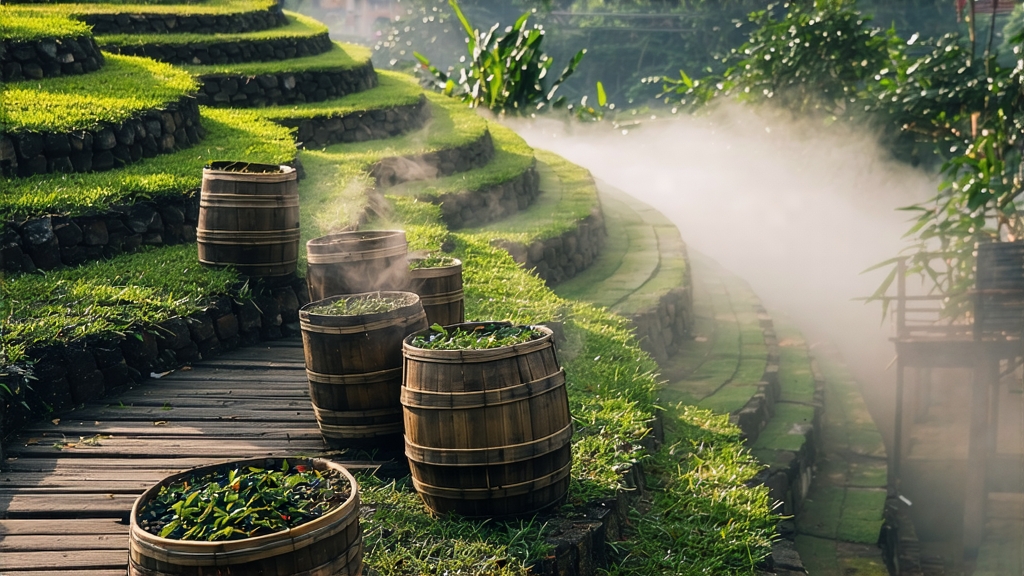
Tucked away in the subtropical hills of southern China, Liu Bao is the quiet genius of the dark-tea family. While Pu-erh grabs headlines, Liu Bao has spent four centuries perfecting the art of subtlety, trading the camphor bombast of Yunnan for a mellow, woody whisper that lingers like incense in an old temple. To understand Liu Bao is to listen to a story told in microbial time—one that begins with Ming-dynasty porters and ends in your teacup with notes of red dates, betel nut, and the faintest trace of vanilla.
Historical footprints
The name “Liu Bao” literally means “Six Forts,” a reference to the six staging posts that once guarded the trade route between the tea-producing county of Cangwu and the port of Wuzhou. From the late 1500s onward, leaf grown by the Yao and Han mountain villagers was carried by shoulder pole down to the Yong River, compressed into coarse baskets, and loaded onto bamboo rafts bound for Hong Kong and, eventually, Southeast Asia. The British colonial records of 1850s Singapore list “Liu-po” as a medicinal tea prescribed for “reducing humidity and restoring appetite,” proof that the tea had already become a diasporic comfort long before the word “probiotic” existed.
Terroir and leaf style
Liu Bao’s microclimate is a steamy marriage of red lateritic soil, morning fog, and the karst-filtered waters of the Gui River. The indigenous cultivar, dubbed “Zhong ye zhong” (mid-leaf strain), sports thick, leathery blades rich in polyphenols and pectin—ideal fodder for the long microbial conversation that follows harvest. Unlike the broad-leaf Assamica that defines Pu-erh, Zhong ye zhong is a Camellia sinensis var. sinensis variant, giving Liu Bao a narrower leaf, tighter curl, and a lighter body that can still age for decades without collapsing into flat earthiness.
Crafting the darkness
The journey from fresh leaf to “Chen Xiang” (aged aroma) is a choreography of heat, moisture, and patience. After the standard withering and rolling, Liu Bao enters its signature “dui zi” wet-pile phase. Workers build 1.5-meter heaps on cement floors, misting them with river water until the core temperature climbs to 55 °C. Every 48 hours the piles are turned by shovel, aerating the mass so that dominant microbes—Aspergillus niger, Blastobotrys adeninivorans, and a lactic acid consortium—can trade places. After 10–15 days the leaf turns chestnut brown, its bitterness replaced by a sweet, loamy scent reminiscent of rain on hot bricks.
Next comes the unique “Song Zhen” (pine-firing). The tea is spread on bamboo trays suspended over smoldering pine logs for 20 minutes, a flash of heat that fixes color and imparts a whisper of resin. Finally the leaf is packed into 40 kg bamboo baskets lined with wild taro leaves; the slight alkalinity of the taro neutralizes residual acids, while the basket’s breathability allows a slow, even oxidation that can last 30 years or more. The best vintages acquire a white frost of “golden flowers”—Eurotium cristatum—the same mold prized in Fuzhuan brick tea, visible proof of microbial harmony.
Grades and tasting lexicon
Liu Bao is unofficially graded by basket weight and leaf maturity. “First-grade spring” (tou chun) consists of one bud and two leaves, yielding a bright orange liquor and a honeysuckle top note. “Third-grade summer” (san xia) uses larger blades, giving a deeper amber cup and the classic betel-nose bite. Aged examples are coded by decade: 90s baskets offer camphor and dried longan; 80s baskets slide into woody vanilla; pre-1970s “lao cha” can smell of antique parchment and sweet potato cellar, with a texture so smooth it feels like sipping warm jade.
Brewing ritual, Gongfu style
Begin by awakening the tea: pry 5 g from the basket, steam it for three seconds over boiling water to rehydrate the compressed layers, then place it in a warmed 120 ml Yixing teapot. Flash-rinse at 100 °C, discard, and proceed with 8 infusions, starting